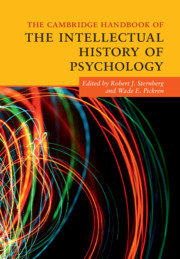Book contents
- The Cambridge Handbook of the Intellectual History of Psychology
- The Cambridge Handbook of the Intellectual History of Psychology
- Copyright page
- Contents
- Figures
- Tables
- Contributors
- Introduction
- 1 Major Paradigms and Approaches in Psychology
- 2 Methodology in Psychology
- 3 Neuroscience in Psychology
- 4 Sensation and Perception
- 5 Attention: Awareness and Control
- 6 Learning
- 7 Memory
- 8 Decision-Making
- 9 Creativity
- 10 Intelligence
- 11 Development
- 12 Social Psychology
- 13 Gender
- 14 Emotion
- 15 Motivation
- 16 Personality
- 17 Abnormal Psychology
- 18 Psychotherapy
- 19 Health Psychology
- Index
- References
7 - Memory
Published online by Cambridge University Press: 18 May 2019
- The Cambridge Handbook of the Intellectual History of Psychology
- The Cambridge Handbook of the Intellectual History of Psychology
- Copyright page
- Contents
- Figures
- Tables
- Contributors
- Introduction
- 1 Major Paradigms and Approaches in Psychology
- 2 Methodology in Psychology
- 3 Neuroscience in Psychology
- 4 Sensation and Perception
- 5 Attention: Awareness and Control
- 6 Learning
- 7 Memory
- 8 Decision-Making
- 9 Creativity
- 10 Intelligence
- 11 Development
- 12 Social Psychology
- 13 Gender
- 14 Emotion
- 15 Motivation
- 16 Personality
- 17 Abnormal Psychology
- 18 Psychotherapy
- 19 Health Psychology
- Index
- References
Summary
Although people have theorizing about memory for millennia, its careful experimental study began only in the late nineteenth century. Since then, its study has matured into one of the richest and most fully developed topics in psychological research. In this chapter, we present a historical survey of behavioral methods for studying human memory. We begin with the founders of two research traditions, Hermann Ebbinghaus and Frederic Bartlett. Their seminal research, based in laboratory and field methods, shaped how subsequent memory researchers conduct their science. We trace the evolution of memory research through several phases: the verbal learning tradition following Ebbinghaus, which was then broadened in the 1960s with studies of organization in memory and the information-processing tradition. We then continue with brief discussions of more contemporary research on working memory, episodic memory, autobiographical memory, and implicit memory, as well as social remembering. We also touch on the development of applied memory research in several realms. While early researchers attempted to find general laws governing all memory, 150 years of research have revealed no such laws. Rather, the tapestry of different but complementary research traditions has provided rich and continually growing insight into our understanding of human memory.
Keywords
- Type
- Chapter
- Information
- The Cambridge Handbook of the Intellectual History of Psychology , pp. 165 - 215Publisher: Cambridge University PressPrint publication year: 2019



